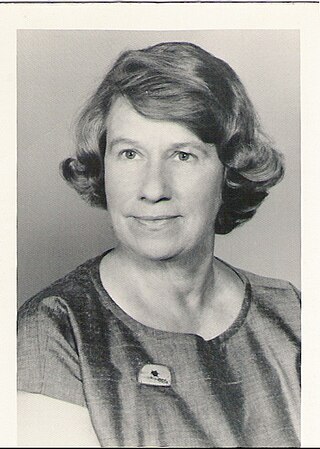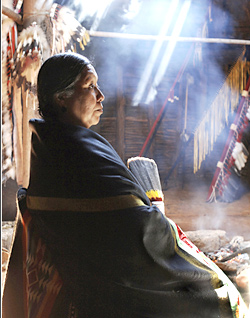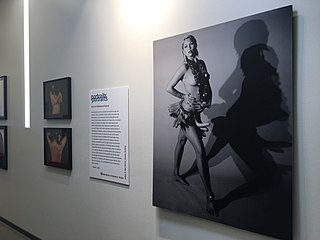Related Research Articles

The Institute of American Indian Arts (IAIA) is a public tribal land-grant college in Santa Fe, New Mexico, United States. The college focuses on Native American art. It operates the Museum of Contemporary Native Arts (MoCNA), which is housed in the historic Santa Fe Federal Building, a landmark Pueblo Revival building listed on the National Register of Historic Places as Federal Building. The museum houses the National Collection of Contemporary Indian Art, with more than 7,000 items.

Dorothy Dunn Kramer was an American art instructor who created The Studio School at the Santa Fe Indian School.

Tommy Wayne Cannon was an important Native American artist of the 20th century. He was popularly known as T. C. Cannon. He was an enrolled member of the Kiowa Indian Tribe of Oklahoma and had Caddo and French ancestry.

The Santa Fe Indian Market is an annual art market held in Santa Fe, New Mexico on the weekend following the third Thursday in August. The event draws an estimated 150,000 people to the city from around the world. The Southwestern Association for Indian Arts (SWAIA) organizes the market, showcasing work from 1,200 of the top Native American artists from tribes across the country.

Pablita Velarde born Tse Tsan was an American Pueblo artist and painter.

George Morrison was an Ojibwe abstract painter and sculptor from Minnesota. His Ojibwe name was Wah Wah Teh Go Nay Ga Bo. Morrison's work is associated with the Abstract Expressionist movement in the United States.
Nora Naranjo Morse is a Native American artist and poet. She currently resides in Española, New Mexico just north of Santa Fe and is a member of the Santa Clara Pueblo. Her work can be found in several museum collections including the Heard Museum in Phoenix, Arizona, the Minneapolis Institute of Art in Minnesota, and the National Museum of the American Indian in Washington, DC, where her hand-built sculpture piece, Always Becoming, was selected from more than 55 entries submitted by Native artists as the winner of an outdoor sculpture competition held in 2005. In 2014, she was honored with a NACF Artist Fellowship for Visual Arts and was selected to prepare temporal public art for the 5x5 Project by curator Lance Fung.

Linda Lomahaftewa is a Hopi and Choctaw printmaker, painter, and educator living in Santa Fe, New Mexico.
Teri Greeves is a Native American beadwork artist, living in Santa Fe, New Mexico. She is enrolled in the Kiowa Indian Tribe of Oklahoma.

James Luna was a Puyukitchum, Ipai, and Mexican-American performance artist, photographer and multimedia installation artist. His work is best known for challenging the ways in which conventional museum exhibitions depict Native Americans. With recurring themes of multiculturalism, alcoholism, and colonialism, his work was often comedic and theatrical in nature. In 2017 he was awarded a Guggenheim Fellowship.

Vanessa Paukeigope Santos Jennings is a Kiowa/Kiowa Apache/Gila River Pima regalia maker, clothing designer, cradleboard maker, and beadwork artist from Oklahoma.

Erica Lord is an Alaska Native artist, based in Santa Fe, New Mexico, who identifies herself as a mixed-race "cultural limbo."
Lloyd Henri Kiva New was a pioneer of modern Native American fashion design and a cofounder and president emeritus of the Institute of American Indian Arts (IAIA) in Santa Fe, New Mexico.
Dyani White Hawk is a contemporary artist and curator of Sicangu Lakota, German, and Welsh ancestry based out of Minnesota. From 2010 to 2015, White Hawk was a curator for the Minneapolis gallery All My Relations. As an artist, White Hawk's work aesthetic is characterized by a combination of modern abstract painting and traditional Lakota art. White Hawk's pieces reflect both her Western, American upbringing and her indigenous ancestors mediums and modes for creating visual art.

Jeri Ah-be-hill was a Kiowa fashion expert and art dealer. She owned and operated a trading post on the Wind River Indian Reservation for more than twenty years before moving to Santa Fe, New Mexico where she became the curator of the annual Native American Clothing Contest held at the Santa Fe Indian Market. She also worked as a docent at both the Institute of American Indian Arts and the Wheelwright Museum of the American Indian. Considered an expert on Native American fashion, she traveled nationally presenting educational information about tribal clothing.
Cara Romero is a Chemehuevi photographer from the United States. She is known for her dramatic digital photography that examines Indigenous life through a contemporary lens. She lives in both Santa Fe, NM and the Mojave Desert.
Christine McHorse, also known as Christine Nofchissey McHorse, was a Navajo ceramic artist from Santa Fe, New Mexico.
Julie Buffalohead is a contemporary Indigenous American artist. Her work mainly focuses on themes of racial injustice, indigenous rights, and abuse of power.
Darren Vigil Gray is a Jicarilla Apache painter and musician. He draws inspiration for his work from abstract expressionists such as Jackson Pollock and from his heritage.
References
- 1 2 3 4 Joseph, Dana (2015). "David Bradley's Indian Country". Cowboys & Indians . No. August/September. Retrieved 3 March 2017.
- ↑ Bradley, David (1991). “Restless Native.” Plains Art Museum ISBN 0934266328
- ↑ Manifestations: New Native Art Criticism. Santa Fe, NM (USA): Museum of Contemporary Native Arts. 2011. p. 86. ISBN 9780615489049. OCLC 904871040.
- ↑ Hill, Rick, ed. (1992). "Creativity Is Our Tradition: Three Decades of Contemporary Art at the Institute of American Indian Arts." Institute of American Indian Arts ISBN 1881396045.